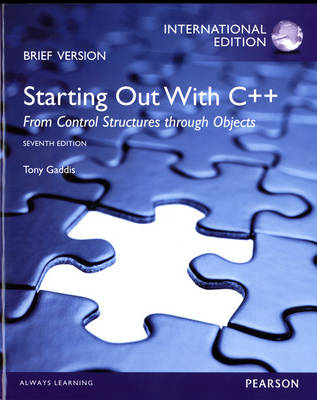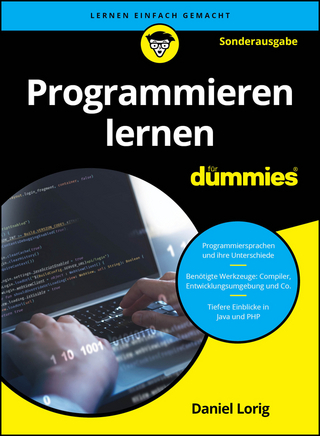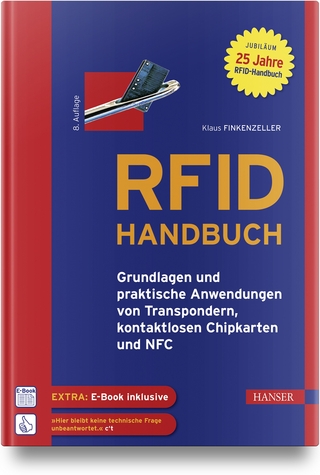
Starting Out with C++
Pearson (Verlag)
978-0-13-310002-0 (ISBN)
- Titel erscheint in neuer Auflage
- Artikel merken
This book includes the first 15 chapters from the best–selling Starting Out with C++: From Control Structures through Objects, and covers the core programming concepts that are introduced in the first semester introductory programming course.
MyProgrammingLab for Starting Out with C++ is a total learning package. MyProgrammingLab is an online homework, tutorial, and assessment program that truly engages students in learning. It helps students better prepare for class, quizzes, and exams–resulting in better performance in the course–and provides educators a dynamic set of tools for gauging individual and class progress. And, MyProgrammingLab comes from Pearson, your partner in providing the best digital learning experiences.
¿
Note: If you are purchasing the standalone text or electronic version, MyProgrammingLab does not come automatically packaged with the text. To purchase MyProgrammingLab, please visit: myprogramminglab.com or you can purchase a package of the physical text + MyProgrammingLab by searching for ISBN 10: 0132926865 / ISBN 13: 9780132926867.¿ MyProgrammingLab is not a self-paced technology and should only be purchased when required by an instructor.
Tony Gaddis is the lead author of the Starting Out with series including Starting Out with Alice, C++, Java™, Visual Basic® 2010 and 2008, Programming Logic & Design, and Python. Visit the Gaddis Books website for more information on Gaddis’ titles. Gaddis teaches computer science courses at Haywood Community College in North Carolina. He previously taught programming for several corporations and government agencies, including NASA's Kennedy Space Center. Gaddis is a highly acclaimed instructor who was selected as the North Carolina Community College "Teacher of the Year" in 1994, and who received the Teaching Excellence award from the National Institute for Staff and Organizational Development in 1997.
Preface xvii
CHAPTER 1 Introduction to Computers and Programming 1
1.1 Why Program? 1
1.2 Computer Systems: Hardware and Software 3
1.3 Programs and Programming Languages 8
1.4 What is a Program Made of? 13
1.5 Input, Processing, and Output 17
1.6 The Programming Process 18
1.7 Procedural and Object-Oriented Programming 22
CHAPTER 2 Introduction to C++ 27
2.1 The Parts of a C++ Program 27
2.2 The cout Object 31
2.3 The #include Directive 36
2.4 Variables and Literals 37
2.5 Identifiers 41
2.6 Integer Data Types 42
2.7 The char Data Type 47
2.8 The C++ string Class 51
2.9 Floating-Point Data Types 53
2.10 The bool Data Type 56
2.11 Determining the Size of a Data Type 57
2.12 Variable Assignments and Initialization 58
2.13 Scope 59
2.14 Arithmetic Operators 60
2.15 Comments 68
2.16 Named Constants 70
2.17 Programming Style 72
2.18 If You Plan to Continue in Computer Science: Standard and Prestandard C++ 74
CHAPTER 3 Expressions and Interactivity 85
3.1 The cin Object 85
3.2 Mathematical Expressions 91
3.3 When You Mix Apples and Oranges: Type Conversion 100
3.4 Overflow and Underflow 102
3.5 Type Casting 103
3.6 Multiple Assignment and Combined Assignment 107
3.7 Formatting Output 111
3.8 Working with Characters and string Objects 120
3.9 More Mathematical Library Functions 127
3.10 Focus on Debugging: Hand Tracing a Program 130
3.11 Focus on Problem Solving: A Case Study 132
CHAPTER 4 Making Decisions 149
4.1 Relational Operators 149
4.2 The if Statement 154
4.3 Expanding the if Statement 162
4.4 The if/else Statement 166
4.5 Nested if Statements 169
4.6 The if/else if Statement 176
4.7 Flags 181
4.8 Logical Operators 182
4.9 Checking Numeric Ranges with Logical Operators 189
4.10 Menus 190
4.11 Focus on Software Engineering: Validating User Input 193
4.12 Comparing Characters and Strings 195
4.13 The Conditional Operator 199
4.14 The switch Statement 202
4.15 More About Blocks and Scope 211
CHAPTER 5 Loops and Files 227
5.1 The Increment and Decrement Operators 227
5.2 Introduction to Loops: The while Loop 232
5.3 Using the while Loop for Input Validation 239
5.4 Counters 241
5.5 The do-while Loop 242
5.6 The for Loop 247
5.7 Keeping a Running Total 257
5.8 Sentinels 260
5.9 Focus on Software Engineering: Deciding Which Loop to Use 261
5.10 Nested Loops 262
5.11 Using Files for Data Storage 265
5.12 Optional Topics: Breaking and Continuing a Loop 285
CHAPTER 6 Functions 301
6.1 Focus on Software Engineering: Modular Programming 301
6.2 Defining and Calling Functions 303
6.3 Function Prototypes 311
6.4 Sending Data into a Function 313
6.5 Passing Data by Value 318
6.6 Focus on Software Engineering: Using Functions in a Menu-Driven Program 320
6.7 The return Statement 324
6.8 Returning a Value from a Function 326
6.9 Returning a Boolean Value 334
6.10 Local and Global Variables 336
6.11 Static Local Variables 344
6.12 Default Arguments 347
6.13 Using Reference Variables as Parameters 350
6.14 Overloading Functions 356
6.15 The exit() Function 360
6.16 Stubs and Drivers 363
CHAPTER 7 Arrays 377
7.1 Arrays Hold Multiple Values 377
7.2 Accessing Array Elements 379
7.3 No Bounds Checking in C++ 386
7.4 Array Initialization 389
7.5 Processing Array Contents 394
7.6 Focus on Software Engineering: Using Parallel Arrays 402
7.7 Arrays as Function Arguments 405
7.8 Two-Dimensional Arrays 416
7.9 Arrays with Three or More Dimensions 423
7.10 Focus on Problem Solving and Program Design: A Case Study 424
7.11 If You Plan to Continue in Computer Science: Introduction to the STL vector 427
CHAPTER 8 Searching and Sorting Arrays 451
8.1 Focus on Software Engineering: Introduction to Search Algorithms 451
8.2 Focus on Problem Solving and Program Design: A Case Study 458
8.3 Focus on Software Engineering: Introduction to Sorting Algorithms 464
8.4 Focus on Problem Solving and Program Design: A Case Study 472
8.5 If You Plan to Continue in Computer Science: Sorting and Searching vectors 480
CHAPTER 9 Pointers 491
9.1 Getting the Address of a Variable 491
9.2 Pointer Variables 493
9.3 The Relationship Between Arrays and Pointers 500
9.4 Pointer Arithmetic 504
9.5 Initializing Pointers 506
9.6 Comparing Pointers 507
9.7 Pointers as Function Parameters 509
9.8 Focus on Software Engineering: Dynamic Memory Allocation 518
9.9 Focus on Software Engineering: Returning Pointers from Functions 522
9.10 Focus on Problem Solving and Program Design: A Case Study 529
CHAPTER 10 Characters, C-Strings, and More About the string Class 541
10.1 Character Testing 541
10.2 Character Case Conversion 545
10.3 C-Strings 548
10.4 Library Functions for Working with C-Strings 552
10.5 C-String/Numeric Conversion Functions 563
10.6 Focus on Software Engineering: Writing Your Own C-String-Handling Functions 568
10.7 More About the C++ string Class 574
10.8 Focus on Problem Solving and Program Design: A Case Study 584
CHAPTER 11 Structured Data 593
11.1 Abstract Data Types 593
11.2 Focus on Software Engineering: Combining Data into Structures 595
11.3 Accessing Structure Members 598
11.4 Initializing a Structure 602
11.5 Arrays of Structures 605
11.6 Focus on Software Engineering: Nested Structures 608
11.7 Structures as Function Arguments 612
11.8 Returning a Structure from a Function 615
11.9 Pointers to Structures 618
11.10 Focus on Software Engineering: When to Use ., When to Use ->, and When to Use * 621
11.11 Unions 623
11.12 Enumerated Data Types 627
CHAPTER 12 Advanced File Operations 651
12.1 File Operations 651
12.2 File Output Formatting 658
12.3 Passing File Stream Objects to Functions 660
12.4 More Detailed Error Testing 662
12.5 Member Functions for Reading and Writing Files 665
12.6 Focus on Software Engineering: Working with Multiple Files 672
12.7 Binary Files 674
12.8 Creating Records with Structures 679
12.9 Random-Access Files 683
12.10 Opening a File for Both Input and Output 691
CHAPTER 13 Introduction to Classes 705
13.1 Procedural and Object-Oriented Programming 705
13.2 Introduction to Classes 712
13.3 Defining an Instance of a Class 717
13.4 Why Have Private Members? 728
13.5 Focus on Software Engineering: Separating Class Specification from Implementation 729
13.6 Inline Member Functions 735
13.7 Constructors 738
13.8 Passing Arguments to Constructors 742
13.9 Destructors 750
13.10 Overloading Constructors 754
13.11 Private Member Functions 758
13.12 Arrays of Objects 759
13.13 Focus on Problem Solving and Program Design: An OOP Case Study 763
13.14 Focus on Object-Oriented Programming: Creating an Abstract Array Data Type 770
13.15 Focus on Object-Oriented Design: The Unified Modeling Language (UML) 774
13.16 Focus on Object-Oriented Design: Finding the Classes and Their Responsibilities 777
CHAPTER 14 More About Classes 799
14.1 Instance and Static Members 799
14.2 Friends of Classes 807
14.3 Memberwise Assignment 812
14.4 Copy Constructors 813
14.5 Operator Overloading 819
14.6 Object Conversion 846
14.7 Aggregation 849
14.8 Focus on Object-Oriented Design: Class Collaborations 853
CHAPTER 15 Inheritance, Polymorphism, and Virtual Functions 869
15.1 What Is Inheritance? 869
15.2 Protected Members and Class Access 878
15.3 Constructors and Destructors in Base and Derived Classes 884
15.4 Redefining Base Class Functions 896
15.5 Class Hierarchies 901
15.6 Polymorphism and Virtual Member Functions 907
15.7 Abstract Base Classes and Pure Virtual Functions 921
15.8 Multiple Inheritance 928
Appendix A: Getting Started with Alice 947
Appendix B: The ASCII Character Set 975
Appendix C: Operator Precedence and Associativity 977
Quick References 979
Index 981
Online: The following appendices are available at www.pearsonhighered.com/gaddis.
Appendix D: Introduction to Flowcharting
Appendix E: Using UML in Class Design
Appendix F: Namespaces
Appendix G: Writing Managed C++ Code for the .NET Framework
Appendix H: Passing Command Line Arguments
Appendix I: Header File and Library Function Reference
Appendix J: Binary Numbers and Bitwise Operations
Appendix K: Multi-Source File Programs
Appendix L: Stream Member Functions for Formatting
Appendix M: Introduction to Microsoft Visual C++ 2010 Express Edition
Appendix N: Answers to Checkpoints
Appendix O: Solutions to Odd-Numbered Review Questions
| Erscheint lt. Verlag | 7.12.2012 |
|---|---|
| Sprache | englisch |
| Maße | 200 x 253 mm |
| Gewicht | 1610 g |
| Themenwelt | Mathematik / Informatik ► Informatik ► Programmiersprachen / -werkzeuge |
| ISBN-10 | 0-13-310002-2 / 0133100022 |
| ISBN-13 | 978-0-13-310002-0 / 9780133100020 |
| Zustand | Neuware |
| Informationen gemäß Produktsicherheitsverordnung (GPSR) | |
| Haben Sie eine Frage zum Produkt? |
aus dem Bereich


